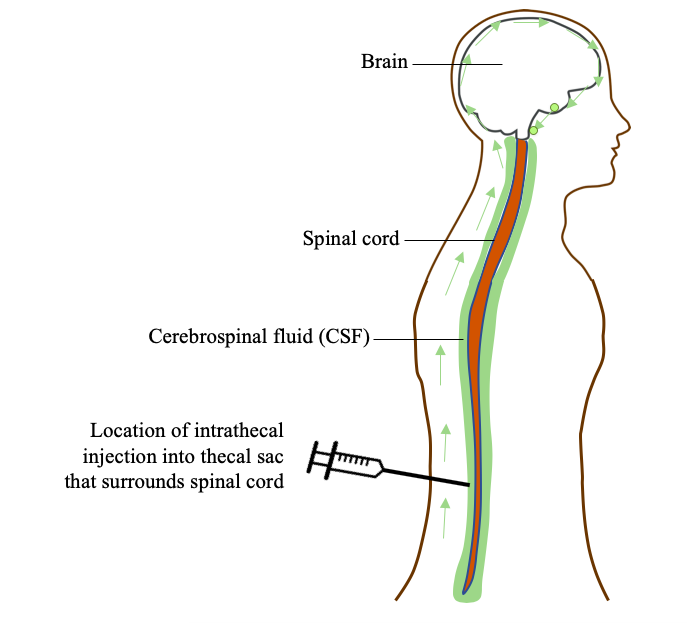Drug delivery into the body can be achieved in several ways, from applying a medicated cream on the skin, to swallowing a pill, to injecting into a muscle or vein. Each route of delivery should at least achieve one thing – getting the drug to the part of the body where it can be helpful. Delivering therapeutic drugs into the brain, however, can be more difficult. Intrathecal injections are used to overcome this challenge.

When a drug enters the body, it travels through the bloodstream until it reaches the target organs. But when a drug is destined to reach the brain, it needs to pass through a unique security feature known as the blood-brain barrier. The blood-brain barrier is important for keeping harmful and unknown substances out of the brain. It turns out that the majority of drugs injected into the body cannot pass this barrier. This poses a challenge for researchers and doctors for delivering important drug treatments to the brain.
One way that drugs can be delivered to the brain via the blood is by modifying their chemical nature slightly. This can help with entry through the blood-brain barrier. A more straightforward route of delivery is by injecting drugs into the brain space directly. Your brain inside your head and spinal cord along your back are bathed in and float in a liquid called cerebrospinal fluid (CSF).
CSF is a clear, colourless fluid that protects the brain from injury by absorbing shock, and it helps bring waste products out of the brain. Importantly, as CSF flows, it helps distribute substances around the brain. Injecting a drug directly in the CSF allows that drug to bypass the blood-brain barrier. One of the less invasive ways to access the CSF space is via injection through the thecal sac, the cushiony layer containing CSF that surrounds the spinal cord. This type of injection is therefore known as an “intrathecal injection”.

Intrathecal injections can be very helpful. They are used during surgeries to manage pain (spinal anaesthesia) and to deliver chemotherapeutic agents to target brain cancers. Intrathecal injections becoming an increasingly important route of administration for drugs investigated in neurodegenerative diseases, such as Huntington’s disease, Alzheimer’s disease, ALS, spinal muscular atrophy (SMA), and spinocerebellar ataxias (SCAs). These drugs include antisense oligonucleotides that can be delivered directly to the brain.
However, there are still a few challenges in giving medication through intrathecal injections:
- Medication delivered by intrathecal injections may need to be given quite often. Since the CSF is replenished regularly, the substances are cleared quickly out of the brain and spinal cavity.
- Intrathecal injections involve a needle being inserted into the spine. So they are more invasive and painful than a typical shot or swallowing a pill. This is especially true if multiple injections are needed.
Therefore, researchers and doctors are constantly trying to learn more about how drugs enter the brain. By studying this, they will make improvements in how medication is delivered to patients. Despite these challenges though, intrathecal injections are a clever and important way for delivering critical drugs to the brain to treat a wide range of diseases.
If you would like to learn more about intrathecal injections, take a look at these resources by the Allina Health and Cancer Research UK.
Snapshot written by Claudia Hung and edited by Judit M. Pérez Ortiz










